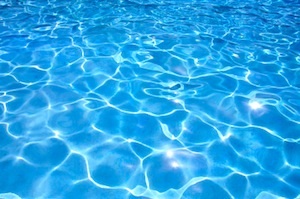Chlorine is a naturally occurring element and, as part of the literal salt of the earth, very abundant. Humans have harnessed chlorine and most commonly use it for disinfecting purposes. Unfortunately, chlorine’s potential toxicity is not limited to mold and fungus and has actually been linked to serious health dangers for humans.

Chlorine as a Disinfectant
Chlorine is in many household cleaners, it’s used as a fumigant, and, since it impedes the growth of bacteria like e. coli and giardia, and is often added to water systems as a disinfectant. Subsequently, much exposure happens by drinking treated tap water. While disinfection of drinking water is a necessary measure to reduce diseases, concerns have been raised about the safety of chlorine, which has been linked to serious adverse health effects, including dementia http://www.dreddyclinic.com/forum/viewtopic.php?f=34&t=32005 in elderly patients. [1]
Chlorine in Swimming Pools
Swimming pool water must be cleaned, by some means, to prevent contamination and bacterial overgrowth. Chlorine isn’t the safest method, but is probably the most common. Consider what chlorine is- a poison. Diluting it just enough so that it’s strong enough to kill pool scum but not quite strong enough to kill a human doesn’t change that.
A review of available research (and there is a lot of it) by Marywood University confirms that long-term exposure to chlorinated pools can cause symptoms of asthma in swimmers. [2] This can affect athletes who were previously healthy, especially adolescents. [3] Additionally, eye and skin irritation in swimmers has been hypothesized to originate from chlorine exposure. [4]
Did you know that swimming pool chlorine is associated with tooth enamel erosion? It’s not often mentioned but the New York University College of Dentistry lists it as a prime concern. [5]
Harmful Chlorine Exposure
Millions of accidents and injuries happen every year in American homes, many of them involve exposure to toxic chemicals like bleach. Bleach can release chlorine gas and irritate the respiratory system if inhaled. If you’ve ever used this nasty stuff to clean a shower in a closed space, you have likely experienced the burn. [6] Consider this, chlorine is toxic enough to be a chemical weapon and categorized as a “choking agent”. [7] Inhalation of chlorine gas can cause difficulty breathing, chest pains, cough, eye irritation, increased heartbeat, rapid breathing, and death. Exposure would be a very traumatic experience. [8]
In fact, the Dorn VA Medical Center in Columbia, South Carolina reported a chlorine spill accident that happened in South Carolina in January of 2005. Ten months after the event, exposure victims were still so shaken that many reported recurring PTSD symptoms. [9]

Reducing Chlorine Exposure
Much chlorine exposure happens by choice and by simply making new choices you can help reduce exposure risks. If you have a pool, avoid chlorine products. There are alternative methods that can be used to keep pools disinfected, including silver-copper ion generators and salt water.
Avoid home cleaning products that contain chlorine. There are natural and organic alternatives available. You can even make your own.
One of the most significant measures you can take is to always drink purified water and consider a water purification system for your home. It will help to reduce toxins before the water even comes out the faucet.
References:
1. Siritapetawee J, Pattanasiriwisawa W, Sirithepthawee U. Trace element analysis of hairs in patients with dementia http://www.ncbi.nlm.nih.gov/pubmed/20157282. J Synchrotron Radiat. 2010 Mar;17(2):268-72. doi: 10.1107/S0909049509055319. Epub 2010 Jan 16.
2. Fisk MZ, Steigerwald MD, Smoliga JM, Rundell KW. Asthma in swimmers: a review of the current literature http://www.ncbi.nlm.nih.gov/pubmed/21150139. Phys Sportsmed. 2010 Dec;38(4):28-34. doi: 10.3810/psm.2010.12.1822. Review.
3. Carlsen KH. The breathless adolescent asthmatic athlete http://www.ncbi.nlm.nih.gov/pubmed/21436348. Eur Respir J. 2011 Sep;38(3):713-20. doi: 10.1183/09031936.00068510. Epub 2011 Mar 24. Review.
4. Florentin A, Hautemanière A, Hartemann P. Health effects of disinfection by-products in chlorinated swimming pools http://www.ncbi.nlm.nih.gov/pubmed/21885333. Int J Hyg Environ Health. 2011 Nov;214(6):461-9. doi: 10.1016/j.ijheh.2011.07.012. Epub 2011 Sep 1. Review.
5. Jahangiri L, Pigliacelli S, Kerr AR. Severe and rapid erosion of dental enamel from swimming: a clinical report http://www.ncbi.nlm.nih.gov/pubmed/21962583. J Prosthet Dent. 2011 Oct;106(4):219-23. doi: 10.1016/S0022-3913(11)60126-1.
6. Mangat HS, Stewart TL, Dibden L, Tredget EE. Complications of chlorine inhalation in a pediatric chemical burn patient: a case reporthttp://www.ncbi.nlm.nih.gov/pubmed/22665132. J Burn Care Res. 2012 Jul-Aug;33(4):e216-21. doi: 10.1097/BCR.0b013e318254d1c8.
7. Anderson PD. Emergency management of chemical weapons injuries http://www.ncbi.nlm.nih.gov/pubmed/22080590. J Pharm Pract. 2012 Feb;25(1):61-8. doi: 10.1177/0897190011420677. Epub 2011 Nov 11. Review.
8. Mohan A, Kumar SN, Rao MH, Bollineni S, Manohar IC. Acute accidental exposure to chlorine gas: clinical presentation, pulmonary functions and outcomeshttp://www.ncbi.nlm.nih.gov/pubmed/20949733. Indian J Chest Dis Allied Sci. 2010 Jul-Sep;52(3):149-52.
9. Ginsberg JP, Holbrook JR, Chanda D, Bao H, Svendsen ER. Posttraumatic stress and tendency to panic in the aftermath of the chlorine gas disaster in Graniteville, South Carolinahttp://www.ncbi.nlm.nih.gov/pubmed/22072223. Soc Psychiatry Psychiatr Epidemiol. 2012 Sep;47(9):1441-8. doi: 10.1007/s00127-011-0449-6. Epub 2011 Nov 10.
Read more
No comments:
Post a Comment